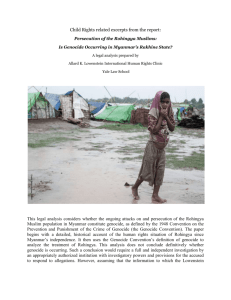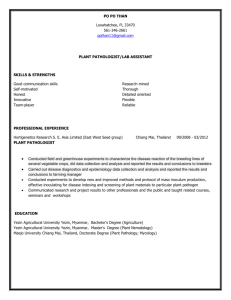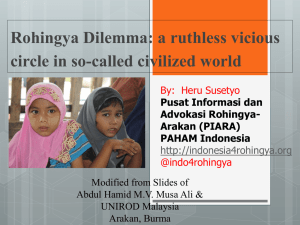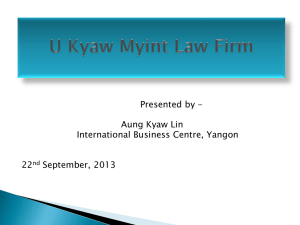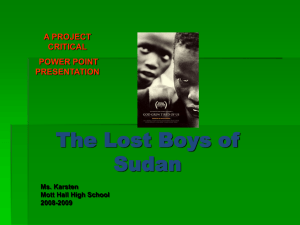Research Report
advertisement
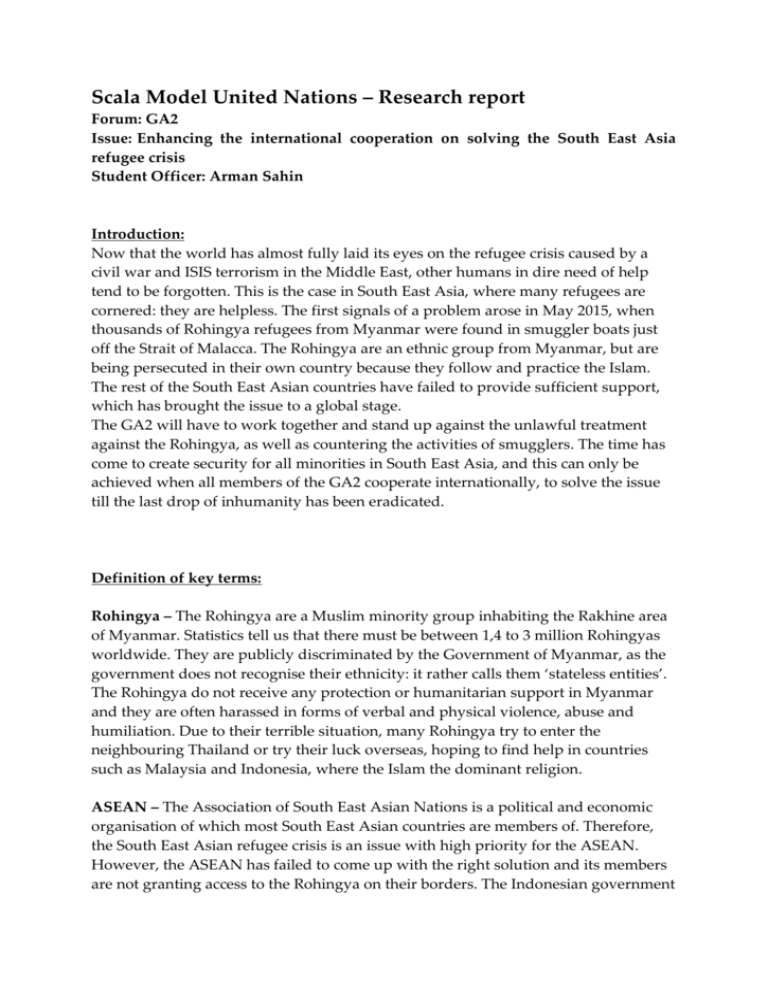
Scala Model United Nations – Research report Forum: GA2 Issue: Enhancing the international cooperation on solving the South East Asia refugee crisis Student Officer: Arman Sahin Introduction: Now that the world has almost fully laid its eyes on the refugee crisis caused by a civil war and ISIS terrorism in the Middle East, other humans in dire need of help tend to be forgotten. This is the case in South East Asia, where many refugees are cornered: they are helpless. The first signals of a problem arose in May 2015, when thousands of Rohingya refugees from Myanmar were found in smuggler boats just off the Strait of Malacca. The Rohingya are an ethnic group from Myanmar, but are being persecuted in their own country because they follow and practice the Islam. The rest of the South East Asian countries have failed to provide sufficient support, which has brought the issue to a global stage. The GA2 will have to work together and stand up against the unlawful treatment against the Rohingya, as well as countering the activities of smugglers. The time has come to create security for all minorities in South East Asia, and this can only be achieved when all members of the GA2 cooperate internationally, to solve the issue till the last drop of inhumanity has been eradicated. Definition of key terms: Rohingya – The Rohingya are a Muslim minority group inhabiting the Rakhine area of Myanmar. Statistics tell us that there must be between 1,4 to 3 million Rohingyas worldwide. They are publicly discriminated by the Government of Myanmar, as the government does not recognise their ethnicity: it rather calls them ‘stateless entities’. The Rohingya do not receive any protection or humanitarian support in Myanmar and they are often harassed in forms of verbal and physical violence, abuse and humiliation. Due to their terrible situation, many Rohingya try to enter the neighbouring Thailand or try their luck overseas, hoping to find help in countries such as Malaysia and Indonesia, where the Islam the dominant religion. ASEAN – The Association of South East Asian Nations is a political and economic organisation of which most South East Asian countries are members of. Therefore, the South East Asian refugee crisis is an issue with high priority for the ASEAN. However, the ASEAN has failed to come up with the right solution and its members are not granting access to the Rohingya on their borders. The Indonesian government explained their reason for not aiding the Rohingya by claiming that more than 50 percent of the refugees on boats were not political Rohingya refugees, but merely illegal economic migrants from Bangladesh who seek their luck in the richer regions of South East Asia. This has not been proven yet, and now that leading members of ASEAN such as Indonesia, Malaysia and Thailand have neglected the problem, the UN has taken up the issue of the ASEAN. Rakhine region - The Rakhine region, also called the Arakan State, is a province of Myanmar. The Rakhine is the only area where the Rohingya are a majority and therefore is a region with high tensions. Most Rohingya refugees start their oversea journey from here. 1951 Refugee Convention – The Refugee Convention dating back to 1951 is an UN treaty which sets the guidelines on the rights of refugees and the responsibilities of the member state that grants the asylum. Unfortunately, the only member of the ASEAN that has signed and ratified this treaty is Cambodia, meaning that all other ASEAN members are not required to follow the treaty and they can decide what to do with refugees all by themselves. Solving the crisis would have been much easier if they had signed and ratified it, as the UN would have been able to implement the rules of the Refugee Convention. ‘Boat people’ – Often used in international media and even by some politicians from ASEAN countries, the term ‘boat people’ refers to the Rohingya people who are stranded and packed with thousand on small smuggler boats at open sea with nowhere to go. Strait of Malacca – The Strait of Malacca is a narrow stretch of water laying in between the Indonesian island of Sumatra and the Malaysian peninsula. Many Rohingya refugees try to enter both Malaysia and Indonesia through the Strait, but instead of safely entering land, thousands of refugees are forced to stay on their boats on the open sea, exposed to all kinds of dangers. The only support Indonesia and Malaysia provide to the Rohingya is small amounts of food, water and fuel. After the Trilateral Meeting between Indonesia, Malaysia and Thailand, Indonesia and Malaysia agree to stop sending back boats onto open sea. Thailand does not sign this agreement. Andaman Sea – The Andaman Sea is another body of water in which many Rohingya seek their luck in order to reach Thailand. It is a dangerous area, especially for the refugees who are very vulnerable to the dangers of the ocean. The Thai government follows the same method as the Indonesians and Malaysians: It provides the refugees with some support and then sends the boats back to the Andaman Sea, claiming that ‘they have enough to continue their journey’. General Overview The Rohingya people are regarded as ‘stateless entities’ by the Government of Myanmar. This means that they are in no means at all protected from discrimination and harassment on Myanmar’s soil. The Rohingya are often described as ‘the most persecuted people of Earth’, to the sole reason of them being predominantly Muslim. Since May 2015, thousands of Rohingya people have been trying to enter the borders of neighbouring South East Asian countries, most of the times without success. The number of Rohingya refugees is estimated to be around 479,000. In addition to this, there are almost a million Rohingya people displaced in the Rakhine region of Myanmar. Smugglers are a big threat to the safety of the Rohingya people, as they try to make a profit from their desperate situation. It is not only the unwillingness of the ASEAN members: the reason for them to deny access to the Rohingya people also has to do with their incapability to host thousands of refugees. The required space, protection, nutrition, and facilities are barely present at all. In addition to this, education and health care are not even things mentioned by the ASEAN member states. The world was shocked in May 2015, when mass graves of Rohingya people were found near to a ‘waiting camps’ in both Thailand and Malaysia. The mass grave that was discovered in Malaysia consisted of more than 135 deceased Rohingya. At this moment, it is estimated that over 350 Rohingya people have died over the last Thus, the Rohingya are not welcome in their own country nor willingly accepted by their South East Asian neighbours. To change their situation in a good way, the GA2 has to build up a resolution that will improve the structure of refugee treatment in the South East Asian region. Timeline of events 1 May, 2015 11 May, 2015 12 May, 2015 14 May, 2015 20 May, 2015 24 May, 2015 29 May, 2015 2 June, 2015 Rohingya mass grave found on the border of Thailand-Malaysia. Many Rohingya had died of starvation and dehydration. Indonesia rescues 2,000 Rohingya refugees from smuggler boats. Indonesia sends 8,000 refugees back to open sea after providing them with supplies, claiming that Indonesia should not be a destination for the Rohingya. Malaysia and Thailand also start sending ‘boat people’ back to the seas. The Arakan Project, an organisation set up for the Rohingya, claims that the refugees have not had any drinking water and food for more than 3 days consecutively. The Trilateral Meeting between Thailand, Malaysia and Indonesia takes place: Indonesia and Malaysia agree to stop sending refugee boats back to the open sea, Thailand does not agree. Pope Francis calls on the international community to support and aid the Rohingya. The ASEAN and a UN delegation meet in Bangkok. The UN claims that the crisis can be solved if Myanmar grants citizenship to the Rohingya, hitting a tense snare for the delegation of Myanmar. President Obama of the United States of America raises awareness about the issue and calls for an end to discrimination towards the Rohingya. Major parties involved Myanmar – The country where the Rohingya originate from. The government of Myanmar has been regarding the Rohingya people as ‘stateless entities’ since the implementation of a population law in 1982. Myanmar’s inhabitants are predominantly Buddhists and have formed a hostile point of view towards the Muslim Rohingya. Myanmar is a member of the ASEAN and has not signed nor ratified the 1951 Refugee Convention. The root cause of the whole refugee crisis is the fact that Myanmar keeps on denying citizenship to the Rohingya, even after several serious remarks by the UN and other parties. Myanmar refuses to call the Rohingya by their ethnic name as it rather calls them ‘Bengalis’ because the government of Myanmar is convinced that the Rohingya people are just illegal migrant workers from Bangladesh. The UN nor any other country can change the population law; Myanmar is the only one who can change its own laws and when we look at the past it doesn’t seem like it will change its ideas about the Rohingya anytime soon. Thailand – Neighbouring Myanmar, Thailand has to do with a lot of refugee influx. The Rohingya enter the Thai borders from both seaway and land. Most of the refugees use Thailand to get to Malaysia, but there are certainly groups that stay. Thailand does not welcome the Rohingya with open arms, and remains one of the only countries that sends incoming ‘boat people’ back to open sea. However, the Thai government has given shelter to some refugees lately. Thailand is a leading member of the ASEAN and has not signed nor ratified the 1951 Refugee Convention. During the Trilateral Meeting, Thailand was the only country that refused to agree on accepting ‘boat people’ onto its shores. In June, Thai police offers were accused of cooperating with smugglers. In addition to this, several Rohingya mass graves were discovered in Thailand as well. Thailand cooperates with the USA’s military and marine in the search for refugee boats in the Indian Ocean. Malaysia – The Rohingya saw Malaysia as the ideal destination for their asylum. As Malaysia is a relatively wealthy country with a predominantly Muslim population, the Rohingya thought that they would be welcomed with more hospitality. The Malaysian government decided otherwise: just as Indonesia had done, it started sending back the boats. However, during the Trilateral Meeting with Indonesia and Thailand, it reversed its course. Malaysia accepted refugees, but has since then kept them in camps on the near border with Thailand. It has been reported that these camps barely meet the basic requirements for survival. Malaysia is the current chair of the ASEAN and has not signed nor ratified the 1951 Refugee Convention. Unfortunately, Malaysia lacks an administrative system that regulates the registration of refugees, making it harder for the Malaysian government to solve the issue. Indonesia – Just as Malaysia, Indonesia seemed to be an ideal destination for the Rohingya. Being relatively wealthy and having the most Muslim inhabitants inside its territory, the Rohingya came with high hopes. Indonesia was the first country to rescue the refugees from their boats on the ocean, but it was also the first to send back boats onto open sea. It stopped doing this right after the Trilateral Meeting and has since then started giving shelter to the refugees. Indonesia has cooperated with the UN through providing registration and protection for the refugees. Indonesia does have to cope with a huge challenge: as its geography opens up the country from so many different sides, the influx of refugees happens widespread throughout the country. This makes it even harder for the Indonesian government to treat all the refugees. Indonesia is the head of the secretariat of the ASEAN and has not signed nor ratified the 1951 Refugee Convention. Map showing all signees of the 1951 Refugee Convention in green. Countries displayed with yellow have only signed the UN’s Refugee Protocol of 1967. Countries in grey have all not signed nor ratified the 1951 Refugee Convention. Previous attempts to solve the issue Over time, many different governments and organisations have tried to come up with solutions. The UN has called upon Myanmar’s government to stop discriminating the Rohingya people and proposed to give them citizenship. Unfortunately, Myanmar refused to do this more than once. The government of Turkey has donated 1$ billion USD to the Rohingya people and the Philippines , Gambia and USA have opened up their borders for the permanent settlement of refugees. Indonesia’s Vice President Jusuf Kalla proposed an old idea to be implemented: he suggested that groups of refugees could be transported to uninhabited islands of the Indonesian archipelago until a better solution was found. This plan did not receive enough support within Indonesia nor from the international community. Many countries in South East Asia came with regional solutions, which only included solutions for their own countries’ part of the problem. These regional solutions do not work as effectively as planned and therefore the UN is now stressing the importance of an internationally followed solution. Possible solutions The GA2 will be stimulated to work together on international level, to find a solution that suits the balance and stabilisation of the South East Asian region of the world. It would be best to find a solution to not only the current crisis, but also to lay a core for a fair and strong structure for future issues. A good place to start would be to take a look at the 1951 Refugee Convention treaty. As almost no ASEAN member state has signed nor ratified this important UN treaty, it might be helpful to look at why the South East Asian countries see no good in it. Also, as the UN, we strive towards equal treatment of all humans worldwide. Myanmar’s attitude towards the Rohingya people should be regarded with high caution. Citizenship for the Rohingya people would be a very helpful solution, but it is not a realistic target as long as Myanmar does not change its ideas. Moreover, at the moment, the only time the ASEAN addressed the refugee crisis was during the Bangkok Meeting. Except for this one time, all countries approached the issue individually, coming up with regional solutions. To enhance international cooperation, the ASEAN might see more interest in addressing the issue as a strong unity instead of tackling it with short-term and weak solutions that do not suffice to eradicate the crisis. It is also important to not forget about countering activities of smugglers in the Indian Ocean. These smugglers take profit from desperate humans and need to be handled effectively. Creating more safety overseas in the South East Asian waters a whole would be a great goal to help solve the issue. Useful documents: http://www.unhcr.org/pages/4b17be9b6.html http://www.unhcr.org/55682d3b6.html https://en.wikipedia.org/wiki/2015_Rohingya_refugee_crisis http://thediplomat.com/2015/07/southeast-asia-refugees-in-crisis/ http://thediplomat.com/2015/09/how-to-solve-southeast-asias-refugee-crisis/ http://www.unhcr.org/pages/49e4877d6.html http://www.theguardian.com/commentisfree/2015/may/15/guardian-viewrohingya-refugee-crisis-cruel-stupid http://thediplomat.com/2015/09/time-to-protect-southeast-asias-refugees/ http://www.asean.org/ http://www.unhcr.org/pages/49da0e466.html
